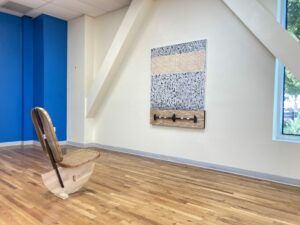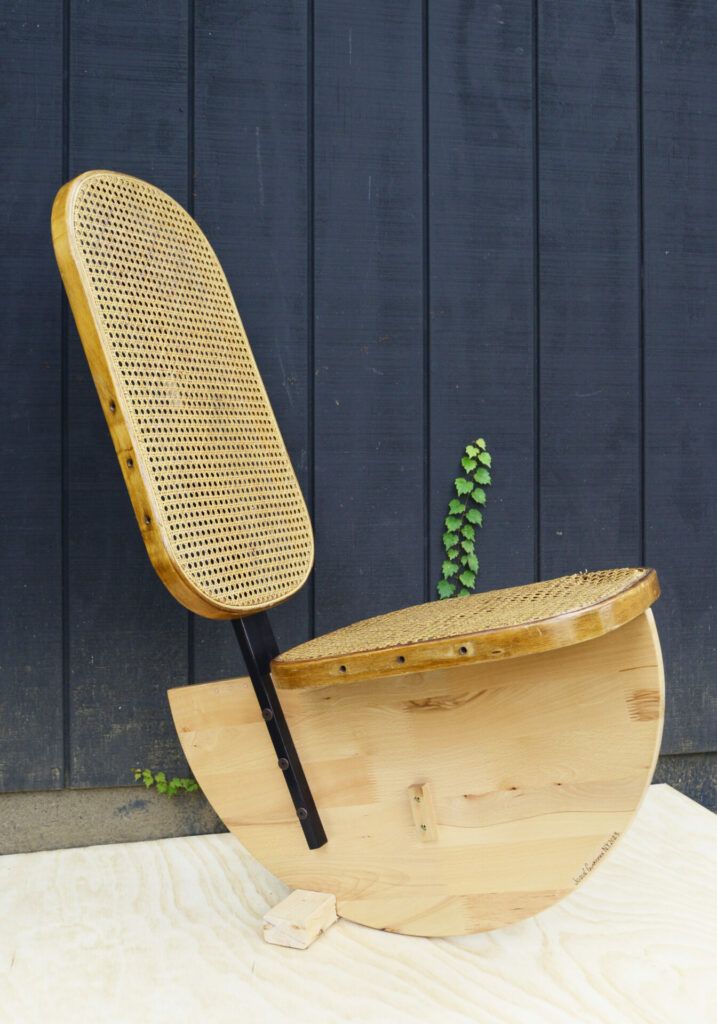
With Precario (2023), a chair-like sculpture constructed from discarded pieces of wooden furniture, Puerto Rican-born, New York-based wood sculptor Josué Guarionex Colón-Rosado (b. 1974) reconfigures the utility of the rocking chair—traditionally a symbol of leisure and comfort—into a visual metaphor for precarious living under oppressive, colonial systems. Disertación criolla (2024), in turn, is a complimentary work of mixed media on canvas, a technical drawing of sorts that deconstructs the speculative and irrational design on which Precario is presumably based. Together, these two works—first exhibited during the fall of 2024 at the Boricua College Art Gallery in the Bronx as part of the group exhibition “Aún presente / Still Here”—offer a critical framework to reevaluate the myopic and decadent inertia of colonial hegemony as part of a larger body of work that explores the nature and abuses of power.
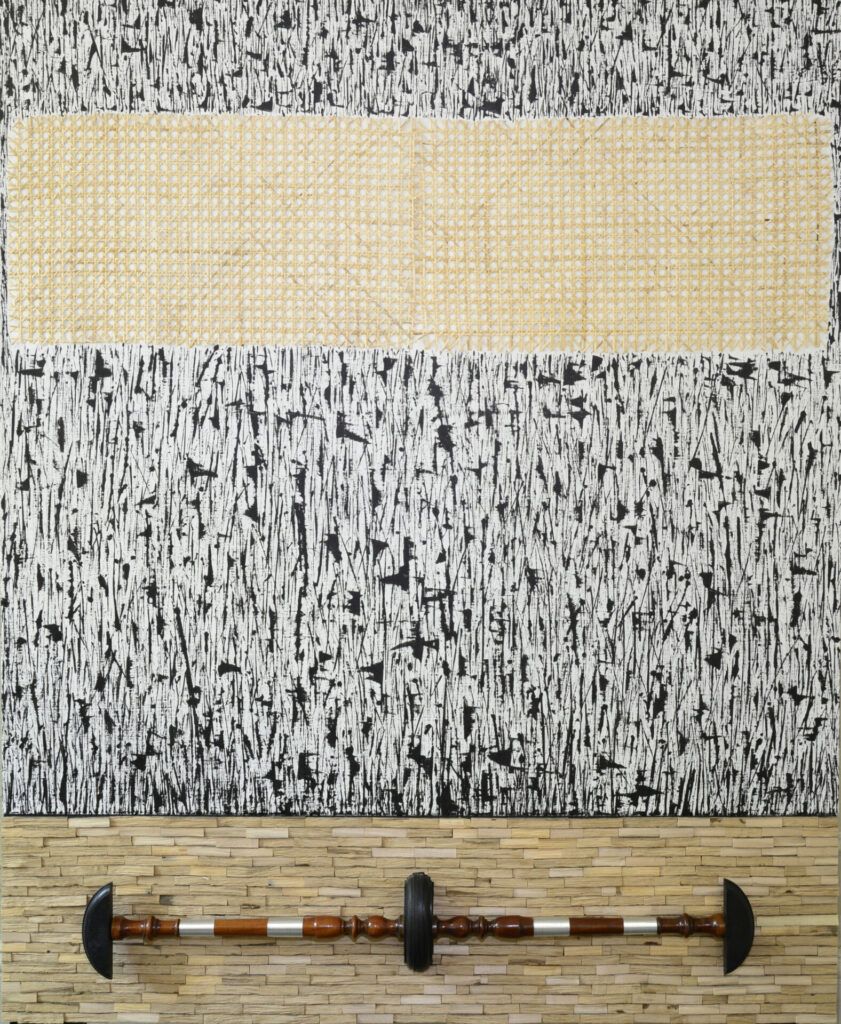
on canas, welding wire, wood, wicker straw, 48″ x 60″ x 4.” Image courtesy of the artist.
Coloniality is built on contradiction, as implied by the seductive illusion of comfort that belies Precario’s corrupt utility. Here, the soothing, periodic motion of the rocking chair is upended by the improvised design of the chair sculpture, which rests upon a tabletop “base” that is purposefully unsteady, yet functional—to the degree one is willing to normalize its flawed composition. Sitting down at one’s peril is then to insist on coping with the inherent structural instability. In the artist’s words: No hice una silla; hice una cultura. Or “I didn’t make a chair; I made a culture.” Precario is merely a byproduct of this colonial inheritance, akin to an anthropological study or time capsule of sorts. As a second-generation woodworker trained in his father’s studio in Puerto Rico, the visual metaphor is concise, aphoristic: materials are adroitly carved and rearranged into a dystopic object, but remain figurative, accessible. The artist’s intervention is therefore generative, relying on his artisanship to retain a sense of agency while adhering to the faulty logic of the colonial imagination. This spectacle of empire, to make life (or art) when and where conditions are less than ideal, is known in Puerto Rico as el arte de bregar. It is a creative, striving impulse that undergirds the satirical commentary of Precario.
The figuration of its brutalist design, moreover, maintains a simulacrum of the original form, i.e. the rocking chair, through a curated assemblage of found objects, including a cane seat bottom and backrest likely taken from a cheap, bentwood rocker—a common casualty of mass production and transience in the urban environment. The use of found objects has long been a preferred method of sourcing materials for the artist since leaving Puerto Rico and returning to New York City in 2011, just two years removed from his first exhibition of woodwork, “Rollingpin=Espacios Ideales,” held in Guatíbiri Gallery in Río Piedras. This creative, seemingly organic process ensures a hybrid design born out of necessity, a self-imposition that also extends to the worsening culture of precarity in Puerto Rico. Ultimately, Precario serves as an inverted proof of concept based on the template later established with Disertación criolla, which, by separating distinct components of Puerto Rican identity onto the canvas, cleverly uses abstraction to add a layer of transparency to this critical exercise in self-reflection; hence the staging of Precario just a few feet before Disertación criolla, facing the wall on which it hangs, a mise en abyme dialectic of sorts.
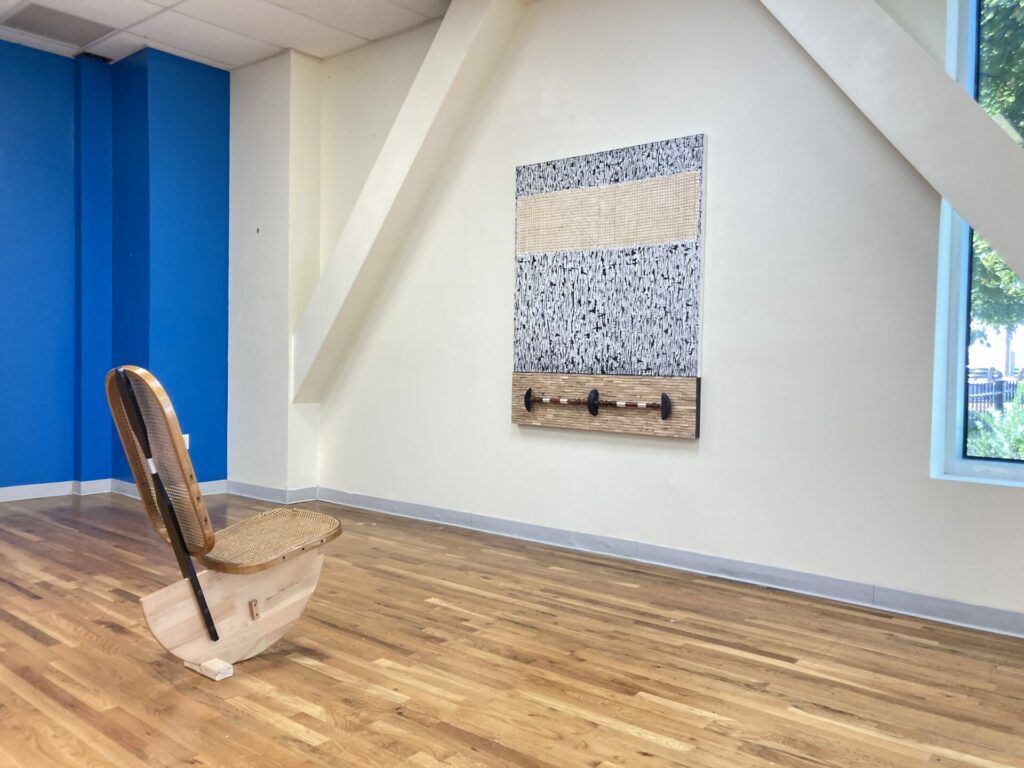
criolla from the group exhibition “Aún aquí / Still Here” at the Boricua
College Art Gallery in the Bronx, NY. Image courtesy of the artist.
The rocking chair is also a nostalgic object that traces colonial narratives to their overlapping contexts—as both a quintessential “American” invention dating back to the early 18th century and a Spanish criollo import turned essential furnishing for Caribbean homes. In the latter case, circumstances would encourage local artisans to meet demand by adapting the design and materials of the rocking chair into a Caribbean context, much like the artist does with Precario, albeit in New York City, where abundance and excess provide another type of inheritance. It’s worth mentioning as well that artisans in Puerto Rico first established a local woodworking industry by the mid-19th century and as a marginalized class, they nonetheless contributed to the creation of an early and distinct manifestation of Puerto Rican identity.
Other objects, like the machete, the baseball bat or the Greca (Moka pot)—all of which form the basis of other recent sculptures and work in progress—similarly align with a more discreet appropriation of otherwise clear symbols of Puerto Rican and Caribbean identity. For the artist, whose family endured surveillance during the waning years of the carpeteo era in Puerto Rico, traditional imagery such as the Puerto Rican flag is necessarily prohibitive, given the acute awareness and experience of targeted harassment to repress political dissidence. The original, sky-blue Puerto Rican flag of independence has instead been adopted by the artist’s mother, an artisan known for handmade, large-scale reproductions of la monoestrellada. The handwoven fabric in Disertación criolla hints at this matrilineal heritage.
What Precario then externalizes and consolidates is the historical sequence of Spanish and US colonialism and imperialism in Puerto Rico—centuries of pervasive influence and exploitation and the resulting material conditions: recurring power outages, massive public debt, state-sponsored repression, land dispossession, and so on. This is the opposite function of Disertación criolla, which is more so a two-dimensional study of internal structures in a more stable format. The black and white “static” of the canvas, reminiscent of another work, Madres en busca de sus hijos (2014–2023), a somber depiction of the ongoing search for the disappeared in Latin America, conveys the hazy circumstances with the same aesthetic vocabulary as Precario. This includes, in addition to the use of found objects and woodwork, the aluminum welding wire wrapped around the beautifully hand-carved table legs of each artwork, a signature design motif for the artist featured in their earliest works, as well as in the more recent Amuleto series, e.g. Péndulo (2023), which was also exhibited at Boricua College. Similar to Precario, this mixed-media sculpture is suspended from the ceiling, with a plumb bob at its tip in reference to verticality, or in the case of the artist, carpentry. The title alludes to an oscillating perspective, a seemingly never-ending back and forth from which the artist activates a Puerto Rican sensibility in the hopes of finding some liberating sense of perspective, embedded in the past and instructive for the future.
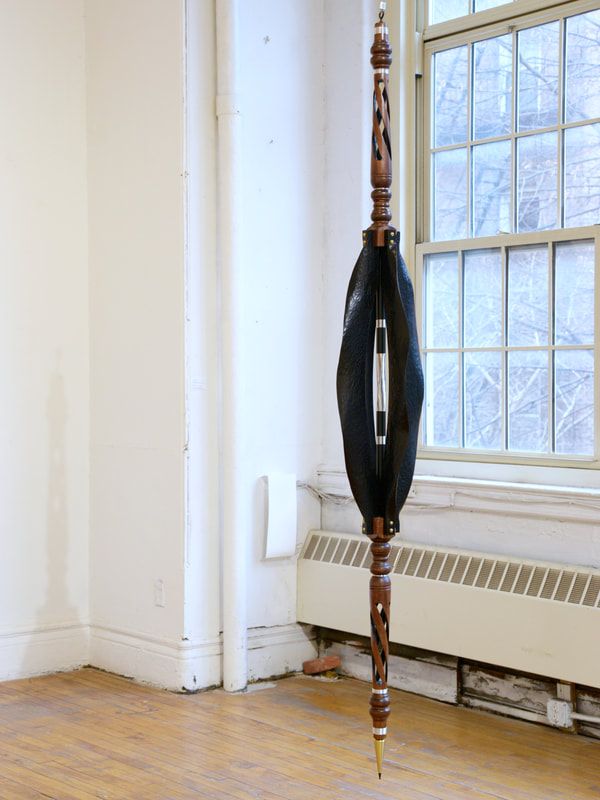
handcarved wood, welding wire, plumb bob. 12″ x 12″ x 90.” Image courtesy of the artist.
References
- Bloodworth, Sandra, and Cheryl Hageman. Contemporary Art Underground: MTA Arts & Design New York. New York, NY: Monacelli Press, 2024, 248–249.
- Colón González, José Luis. Entre talleres y ebanistas: Historia de los principales artífices del mueble puertorriqueño, 1850–1960. San Germán: Universidad Interamericana, 2023.
- Díaz Quiñones, Arcadio. El arte de bregar: ensayos. San Juan, Puerto Rico: Ediciones Callejón, 2003.
- Goyeneche, Teresita. “Al Compás de Una Curvatura.” VICE, July 4, 2019. www.vice.com/es/article/al-compas-de-una-curvatura/.
- Reichard de Cardona, Haydeé. “Memorias Del Ajuar Doméstico Puertorriqueño.” 80grados, May 14, 2021. www.80grados.net/memorias-del-ajuar-domestico-puertorriqueno/.
- Trelles, Rafael. “Josué Guarionex Colón: el nacimiento de un escultor,” unpublished manuscript. Date unknown, Puerto Rico.
